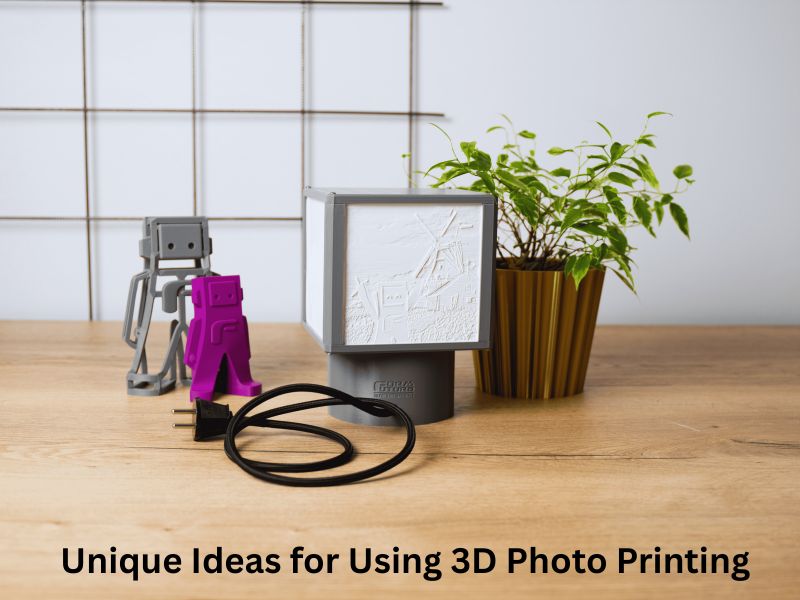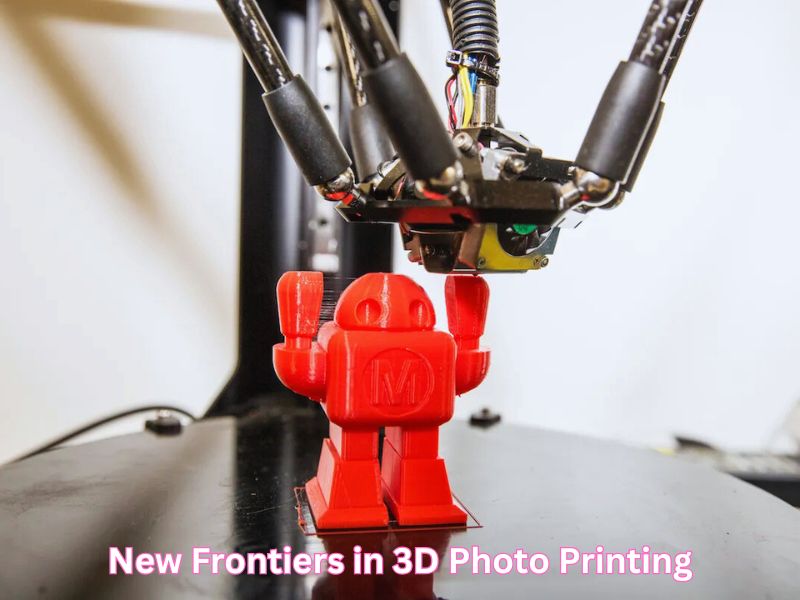As a 3D printing expert with over a decade of hands-on experience, I’ve seen how photos 3D printing has revolutionized the way we preserve our most meaningful moments. This technique transforms flat photographs into detailed 3D objects, such as glowing lithophanes, custom figurines, and engraved crystal keepsakes.
Unlike traditional photo frames, photos 3D printing gives you depth, texture, and a sense of almost lifelike presence. It’s not just about display—it’s about reliving your memories in a personal, interactive, and truly unforgettable way. For small businesses looking to explore this innovative technique, investing in the best 3d printer for small business can make a significant difference in the quality and variety of products you offer.

Understanding the Magic: How 3D Photo Printing Turns Images into 3D Memories
From Snapshot to Sculpture: The Journey of a 2D Photo Becoming a 3D Object
Transforming a flat photograph into a three-dimensional object involves a blend of artistry and technology. Here’s a step-by-step breakdown:
- Selecting the Right Photo: Choose a high-resolution image with clear details and good lighting. Portraits with distinct features work best.
- Converting to a 3D Model: Utilize software like Tinkercad, 3D Slash, or Lithophane Generator to transform your 2D image into a 3D model. These tools interpret your photo’s light and dark areas to create depth.
- Slicing the Model: Once your 3D model is ready, slicing software such as Cura or PrusaSlicer prepares it for printing by dividing it into layers and generating the necessary code for the printer.
- Printing the Object: Load the sliced file into your 3D printer, select appropriate settings, and commence printing. Depending on complexity, prints can take several hours.
How Different Types of 3D Printers Help Bring Your Memories to Life
The choice of a 3D printer significantly influences the quality and detail of your photo-based creations:
- Fused Deposition Modeling (FDM) Printers: Ideal for beginners, FDM printers like the Creality Ender 3 or Anycubic i3 Mega are cost-effective and widely used for creating lithophanes and simple figurines.
- Stereolithography (SLA) Printers: SLA printers such as the Formlabs Form 3 are excellent choices for higher resolution and finer details. They use resin and are perfect for intricate designs like crystal engravings.
Common Materials Used to Print Photo-Based 3D Creations
Selecting the right material is crucial for achieving the desired look and durability:
- PLA (Polylactic Acid): A biodegradable and easy-to-use filament, PLA is popular for printing lithophanes due to its translucency.
- Resin: Used in SLA printers, resin offers high detail and smooth finishes, making it suitable for miniature figurines and crystal-like objects.
- PETG (Polyethylene Terephthalate Glycol): Combining strength and flexibility, PETG is great for durable items.
Popular and Creative Ways 3D Photo Printing is Used to Preserve Special Moments
Using Lithophanes to Turn Photos into Glowing, Backlit Masterpieces
Lithophanes are thin, translucent 3D prints that reveal detailed images when backlit. The light passes through differently by converting a photo into varying thicknesses, creating a stunning visual effect. With the help of photos 3d printing, these unique pieces turn flat images into glowing, touchable art. They are often used as personalized nightlights, window hangings, or decorative lampshades, adding a warm, nostalgic glow to any space.
Creating Miniature Figurines from Photos to Capture Real People in 3D
Turning photographs into miniature 3D figurines is a unique way to commemorate special occasions. Photos 3d printing services allow you to upload photos, which are then transformed into lifelike statues. These figurines make for memorable gifts, wedding cake toppers, or keepsakes that capture the essence of a person in three dimensions.
Engraving Photos into Crystal for Elegant, Long-Lasting Keepsakes
Photos 3d printing technology, especially laser engraving, embeds 3D images into crystal blocks to create elegant and enduring mementos. Companies specialize in crafting these personalized pieces, which are perfect for commemorating weddings, anniversaries, or memorials. The clarity and durability of crystal make these keepsakes treasured heirlooms.

New and Unique Ideas for Using 3D Photo Printing That Add Value to Your Memories
Transforming Photos into Edible Chocolate Shapes with 3D Printers
Innovative techniques now allow for the creation of custom chocolate molds using 3D printing. By designing a mold based on a photo and printing it with food-safe materials, you can produce personalized chocolates for birthdays, weddings, or romantic gifts. This sweet idea is a growing trend in the world of 3D printing, where memories and flavors come together in creative ways.
Helping the Visually Impaired Experience Memories Through Tactile Photo Models
Photos 3d printing also serves as a powerful tool for inclusivity. By converting images into raised, tactile models, individuals who are blind or visually impaired can experience photographs through touch. Organizations are pioneering this approach, enhancing accessibility and allowing everyone to connect with visual memories in a meaningful way.
Starting Your Journey: How to Make 3D Photo Prints at Home or Professionally
Choosing the Right Photo: What Makes a Picture Ideal for 3D Printing
Selecting the appropriate photo is the first step toward a successful 3D print:
- Clarity: Ensure the image is high-resolution with sharp details.
- Contrast: Photos with distinct light and dark areas translate better into 3D models.
- Composition: Simple backgrounds and focused subjects yield the best results.
Simple Tools and Software to Help You Create 3D Models from Photos
For beginners, several user-friendly tools can assist in converting photos to 3D models:
- Tinkercad: A web-based application that’s intuitive and great for basic designs.
- 3D Slash: Offers a fun, block-building approach to 3D modeling.
- Lithophane Generator: Specifically designed for creating lithophanes from images.
These tools simplify the modeling process, making it accessible even for those new to 3D printing.
Should You Do It Yourself or Hire a Professional 3D Printing Service?
Deciding between DIY and professional services depends on your goals and resources:
- DIY: Offers creative control and is cost-effective in the long run, especially if you plan to undertake multiple projects. However, it requires an initial investment in equipment and time to learn the process.
- Professional Services: Ideal for one-time projects or when seeking high-quality results without the learning curve. Companies provide expertise and advanced equipment to bring your vision to life.

Emotional and Personal Impact: Why 3D Printed Memories Feel So Special
Holding a Memory: How 3D Printed Photos Create Deep Personal Connections
There’s something profoundly moving about holding a physical representation of a cherished memory. Picture to 3D Model transformation allows individuals to reconnect with moments from the past in a tangible way. For instance, a family who lost their beloved pet found comfort in a 3D-printed figurine that captured their companion’s likeness, providing a lasting tribute to their bond.
Why More People Want Real, Personalized Keepsakes in the Digital World
In an era dominated by digital media, there’s a growing desire for physical, personalized items that hold sentimental value. Photos 3D printing fulfills this need by transforming fleeting digital images into enduring keepsakes. Whether it’s a wedding, graduation, or a simple family portrait, these tangible memories serve as lasting reminders of life’s most precious moments.

Innovative Applications: Exploring New Frontiers in 3D Photo Printing
Crafting Personalized Jewelry: Turning Memories into Wearable Art
Transform your cherished photographs into unique pieces of jewelry. By using photos 3d printing, you can create custom pendants, charms, or rings that encapsulate special moments. This approach allows for the creation of meaningful accessories that serve as constant reminders of loved ones or significant events.
Designing Custom Home Décor: Bringing Personal Touches to Living Spaces
Utilize photos 3D printing to produce bespoke home décor items. From photo-engraved lampshades that cast familiar silhouettes to decorative wall art featuring 3D-rendered family portraits, the possibilities are vast. These personalized items add a unique and sentimental touch to any home environment.
Developing Educational Tools: Enhancing Learning Through Tactile Experiences
Incorporate 3D printed photographs into educational settings to aid learning. For instance, creating tactile maps or historical figures can provide visually impaired students with hands-on learning experiences. This method fosters inclusivity and enhances comprehension through physical interaction with educational materials.
Producing Customized Event Memorabilia: Capturing Moments in 3D
Offer guests personalized keepsakes by transforming event photographs into 3D printed mementos. Whether it’s a wedding, graduation, or corporate event, attendees can receive miniature replicas or embossed tokens that commemorate the occasion, providing a tangible memory to cherish.
Innovating in Culinary Arts: Creating Edible 3D Photo Replicas
Merge gastronomy with technology by crafting edible photos 3D printing items based on photographs. Chefs and bakers can design custom molds from images to produce chocolates, fondants, or cake toppers that mirror personal photos, adding a flavorful twist to celebrations.
Wrapping Up
In conclusion, photos 3D printing revolutionizes how we preserve and experience memories by transforming flat images into tangible, interactive keepsakes. Whether it’s creating lifelike figurines, personalized jewelry, or tactile models for the visually impaired, this technology offers endless possibilities for customization and personalization. As advancements continue, 3D printing is set to become an integral part of capturing and cherishing life’s most precious moments.
Frequently Asked Questions
What is Photos 3D Printing?
Photos 3D printing is a technique that transforms flat, two-dimensional photographs into detailed, three-dimensional physical objects. This allows memories to be preserved with depth, texture, and a more lifelike presence than traditional photo frames.
How is a 2D photo converted into a 3D model?
The conversion involves four main steps:
Printing the Object: The printer builds the object layer by layer according to the code.
Selecting the Photo: Choose a high-resolution image with clear details and good contrast.
Converting to a 3D Model: Software like Tinkercad, 3D Slash, or a Lithophane Generator interprets the light and dark areas of the photo to create variations in depth and thickness, forming the 3D model.
Slicing the Model: Slicing software (e.g., Cura or PrusaSlicer) divides the 3D model into printable layers, generating the necessary code for the 3D printer.
What is a lithophane?
A lithophane is a thin, translucent 3D print that displays a detailed image only when backlit. The image’s details are created by varying the thickness of the material, which controls how much light passes through, turning a photo into a glowing, touchable work of art.
Besides lithophanes and figurines, what are some creative uses for 3D-printed photos?
Unique applications include:
- Engraving into Crystal: Using laser engraving technology to embed 3D images into crystal blocks for elegant keepsakes.
- Tactile Models for the Visually Impaired: Converting photos into raised models that can be experienced through touch, enhancing accessibility.
- Edible Creations: Designing custom molds from photos with food-safe materials to produce personalized chocolates or cake toppers.
- Customized Jewelry and Home Décor: Creating unique pendants, charms, or photo-engraved lampshades.
Should I use a professional 3D printing service or do it myself (DIY)?
DIY is best if you plan to do multiple projects, want creative control, and are willing to invest in equipment and time to learn the process. Professional Services are ideal for one-time projects, or when you need the highest quality results without the initial investment and learning curve.

Comments are closed.